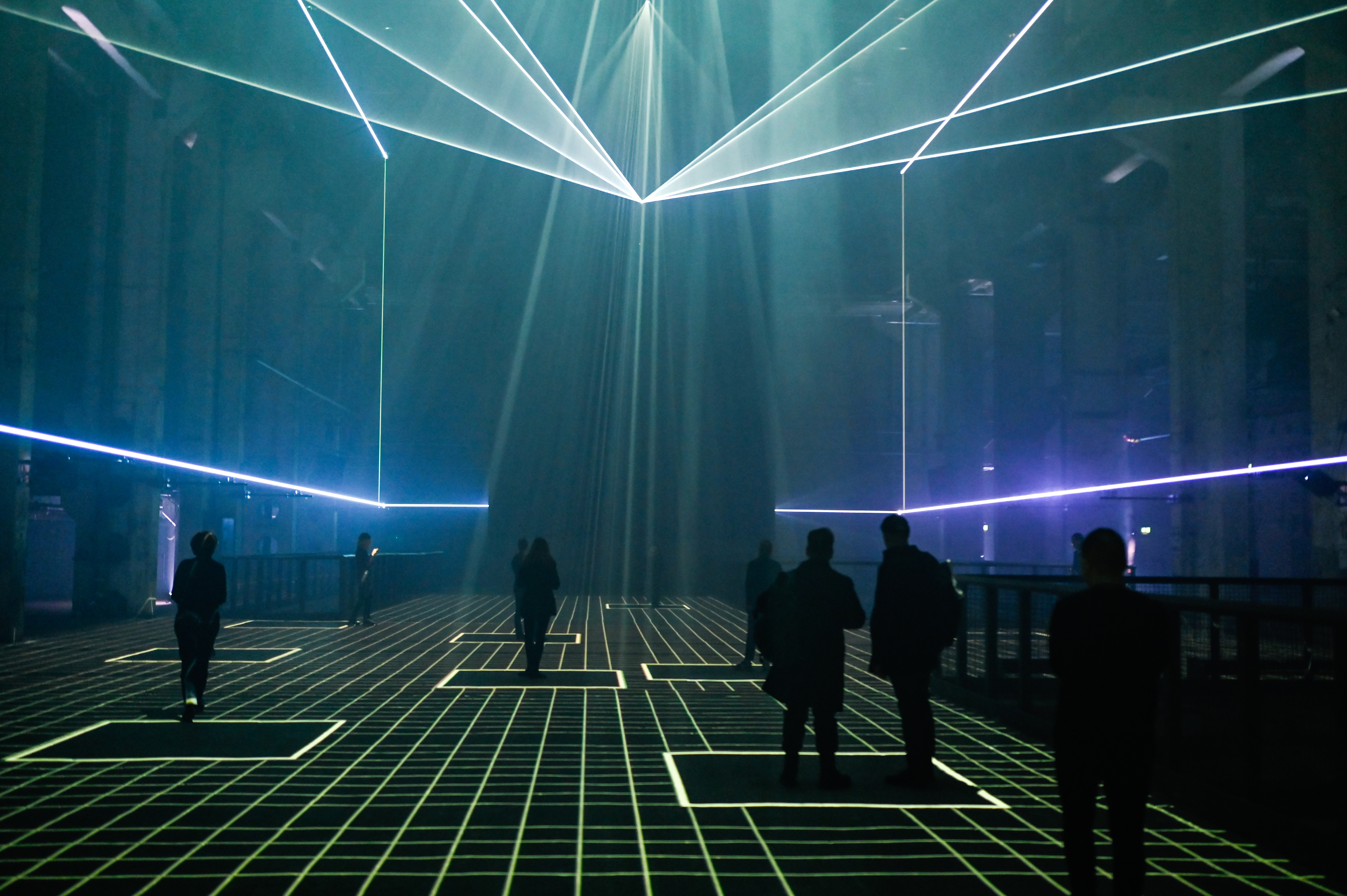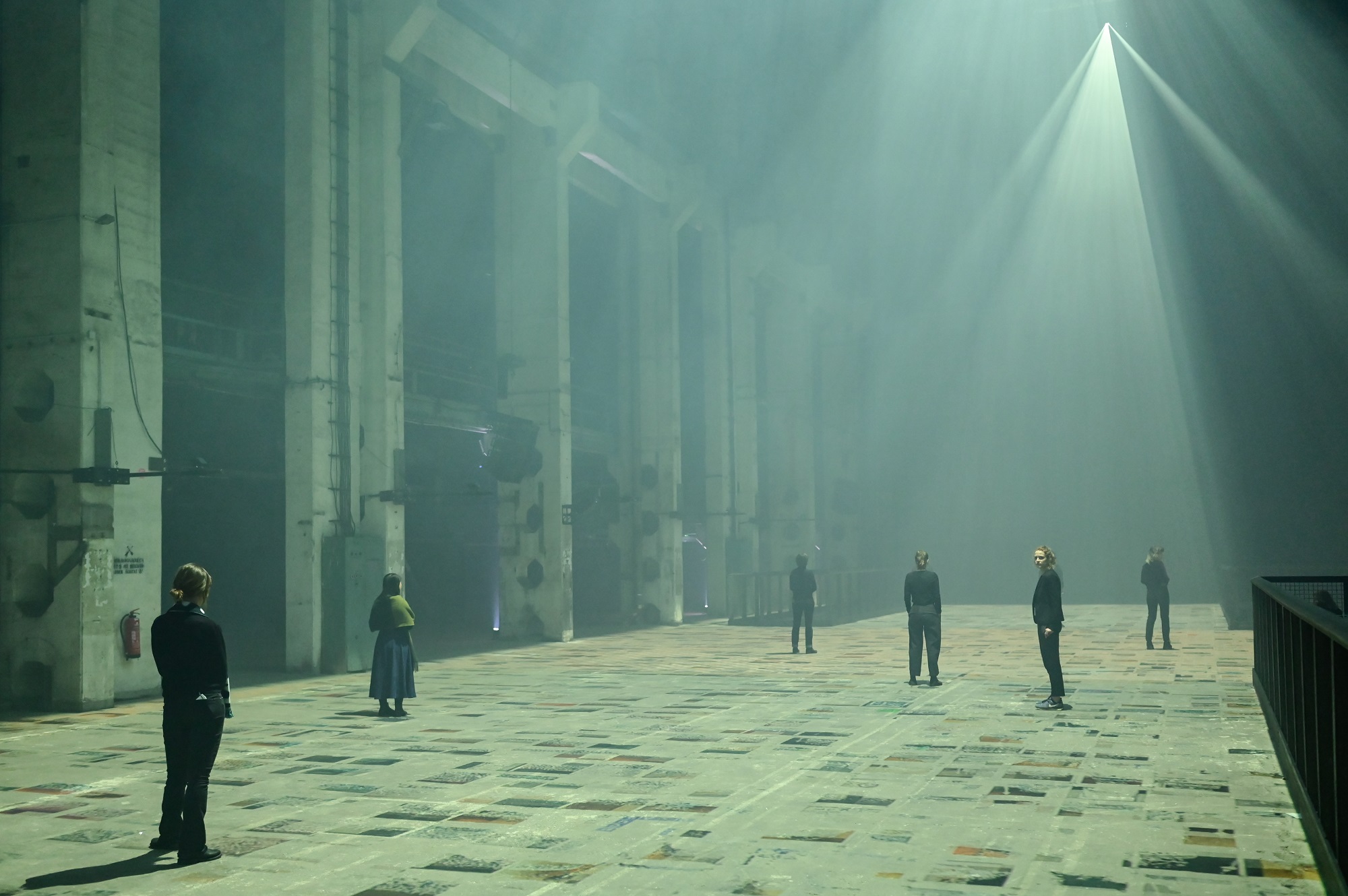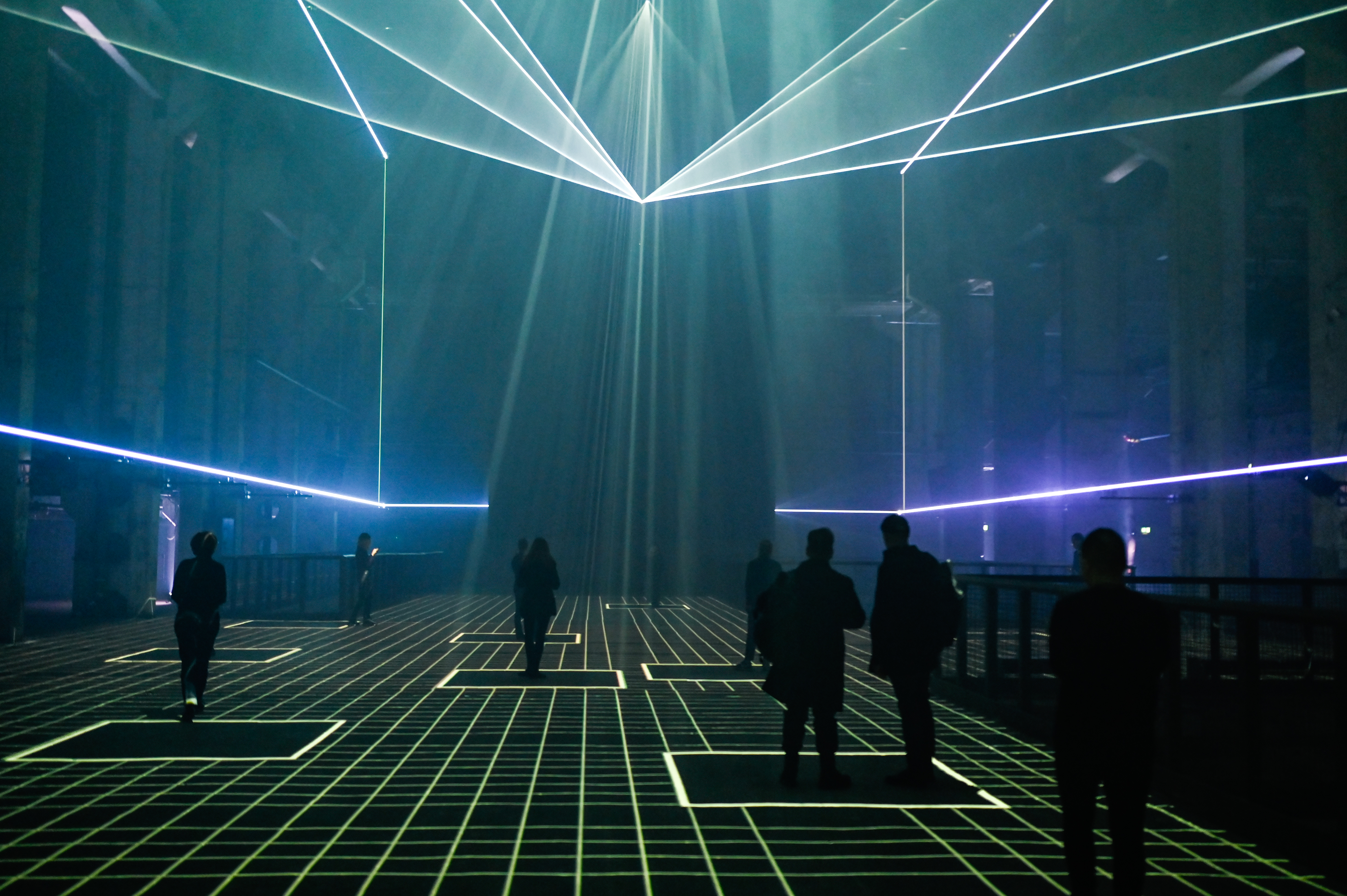
Roaming neon lasers frame the concrete skeleton of Kraftwerk, an 8,000 metre-square 1960s powerplant-turned-nightclub in Berlin. As the building darkens, millions of images of the city zoom across the elevated floor, feeding into its computerized brain. Then, Kraftwerk starts to think: starburst-shaped lasers slice sidelong through the space, intensifying as more smoke rises to meet the majestic triple-height ceiling. The computer sends out squares of light that chase helpless visitors, harvesting data from their movements with a satisfied screech. Finally, the computer’s deep dream hits crescendo as a bone-shaking techno synth introduces a super-sized digital painting of the city, Berlin’s buildings and bodies twisting and morphing in a sandstorm of light and sound.
Latent Being, a psychedelic field day by the Istanbul-born, LA-based media artist Refik Anadol, is an appropriate debut exhibition from Light Art Space (LAS), a new Berlin-based non-profit foundation operating at the intersection of art, technology, and science
. In commissioning the weird, trippy and geeked-out oeuvre of tech-driven multimedia artists and presenting their ideas in an accessible format, LAS intends to fulfil what it perceives as a void in contemporary art exhibitions as well as a lack of intellectual rigour in so-called “immersive art”—which rarely ends up penetrating beyond surface level, and often ends up as naff Instagram fodder.
“We see light as a starting place for exploring a whole spectrum of technological innovation—all the near-future realities yet to be conceived,” explains Dr. Kames. “We want to experiment with artists who are bold enough to take new territory, and who might not find support from public foundations.” While LAS’s interdisciplinary programming shares its aesthetics with the likes of Japanese collective teamLab, Parisian empire of light Atelier des Lumières, and wild-west-indie-kids-turned-corporate-experience-factory Meow Wolf, it is quick to distinguish itself from the competition. “With immersive art, it’s always a thin line between spectacle and substance,” Dr. Kames continues. “In this exhibition and across our programming, we offer a layered approach where sensory experience serves as a universal gateway, but viewers can also dive much deeper should they wish.”
Complex ideas of AI consciousness and human-computer relationships are the conceptual underpinning of Anadol’s half hour-long multisensory installation, in which the blocky concrete skeleton of Kraftwerk is transformed into a sonic and visual cathedral of light. Brought to life by five channel projectors, twelve channel lasers and eight channel sound, Latent Being is the world’s first real-time AI deep dream. Even the accompanying score by sound designer Kerim Karaoglu is AI-generated and includes a plethora of Berlin’s unique soundscapes, from the mundane U-Bahn trip into Mitte to black-out nights at Berghain.
 The artist and foundation worked together to ensure the hefty concepts at play in Anadol’s work had an experiential physical translation. The resulting site-specific installation is a human-machine choreography staged in four acts. First, the machine is fed 10 million archival images of the city of Berlin, spilling across the Kraftwerk’s concrete base in rapid succession. The machine sets to work processing these images through a revolutionary VGG 16 neural network—an “artificial computer brain” comprised of sixteen different layers—that was architectured by Anadol’s silicon valley squad back in California. Light and laser sculptures populate the building while the machine stutters and gurgles as if underwater, providing a multisensory representation of the process at hand.
The artist and foundation worked together to ensure the hefty concepts at play in Anadol’s work had an experiential physical translation. The resulting site-specific installation is a human-machine choreography staged in four acts. First, the machine is fed 10 million archival images of the city of Berlin, spilling across the Kraftwerk’s concrete base in rapid succession. The machine sets to work processing these images through a revolutionary VGG 16 neural network—an “artificial computer brain” comprised of sixteen different layers—that was architectured by Anadol’s silicon valley squad back in California. Light and laser sculptures populate the building while the machine stutters and gurgles as if underwater, providing a multisensory representation of the process at hand.
“If you’ve found your art historical twin via Google, or crossed half your neighbourhood in Pokemon Go, it’s all valuable, powerful data”
The second half of the installation is where the fun really begins, as the machine wisens up to life inside the building. Without warning, dozens of light squares suddenly descend upon unsuspecting visitors below. No matter where they step or how quickly they move, the AI always keeps pace, thanks to the chunky exhibition “ticket” handed to visitors at the entrance. What appears to be a nondescript piece of plastic strung on a lanyard is actually an integrated motion tracking device engineered by Lufthansa.
“It’s not any different to the ways that AI already harvests your data,” muses Rafik. “So we might as well enjoy the sensation of being a product.” The artist refers to our willing if unwitting daily data sacrifice as quid pro quo of our digital lives. All the times you’ve mindlessly decoded captchas on late-night Internet binges, found your art historical twin via Google, or crossed half your neighbourhood in Pokemon Go is valuable, powerful data, used to train AI and machine learning programmes. To some extent, Latent Being is another example of that oft-unknown partnership we all have with machines; here, this dance of data becomes a literal choreography of coding, realized inside a real place and played out in real time.

Yet it is also something much more, too. In the fourth and final chapter of Latent Being, a gigantic projection on the northern end of the building undulates with a hallucinogenic portrait of the city. Subway stations, apartment blocks, bodies of water, architectural icons, and tens of thousands of digitized faces of the city pulse and bleed together. Any text is rendered indecipherable in a total integration of sound, sight and space; the data, translated into brush strokes by StyleGAN, a new concept in Machine Learning, whips and curls around the projected 3D image like a desert sandstorm.
Karaoglu’s accompanying soundscape blends archived sounds of the city with the shuffling of feet, wintery sniffles and iMessage beeps of visitors. The light is blinding, disorienting and captivating; the luminescent flashes and booming bass makes your eyes water and bones shake. Latent Being is a site where the mystical meets the mundane and becomes a transcendental tribute to the city.
“Latent Being is a site where the mystical meets the mundane and becomes a transcendental tribute to the city”
“People will inevitably see this installation as a very sci-fi or steampunk experience of the future, but it’s not so simple—it’s an attempt to make something unreal that feels real,” explains Anadol, who argues that humanity is rapidly approaching a new era where machines will become a fluid facet of architecture and design. By utilizing in an art world context the exact same technology used in space exploration and billion-dollar business development, Anadol wants to open up new opportunities for a general public to understand and fully experience the many exhilarating and at times terrifying ways in which our world will transform as humans and computers become ever closer. “It’s a place for humanity to find its own voice,” says Anadol. “If nothing else, I hope the audience leaves asking themselves, ‘Can computers dream?’”





